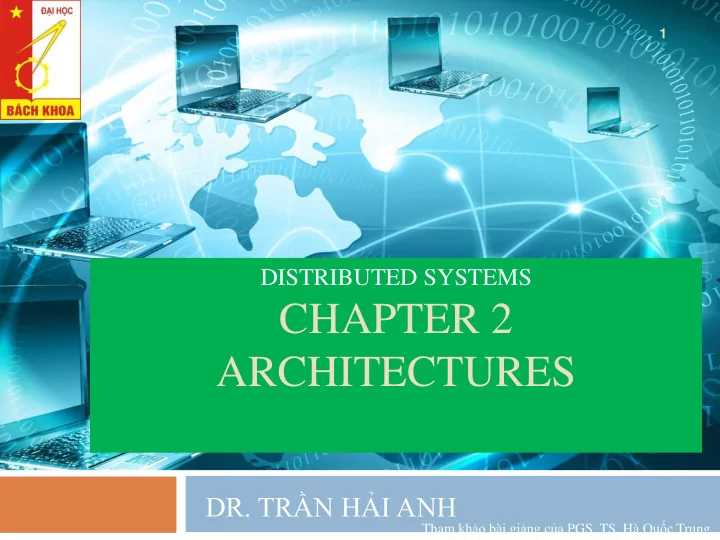

1 DISTRIBUTED SYSTEMS CHAPTER 2 ARCHITECTURES DR. TRẦN HẢI ANH Tham khảo bài giảng của PGS. TS. Hà Quốc Trung
2 Organization of a distributed system: distinction between the logical organization and the physical realization The logical organization: the collection of software components that constitute the system software architecture The physical realization: instantiate and place software components on real machines system architecture
Outline 3 Architectural styles 1. System architectures 2. Architectures versus Middleware 3.
1. Architectural styles 4
Architectural styles 5 Layered architectures Object-based architectures Data-centered architectures Event-based architectures
1.1. Layered achitectures 6 Layered fashion Each layer has its own task Transparency
Layered architectures (con’t) 7 Application Presentation Session Transport Network Data link Physical General DS architecture with Middleware OSI model
1.2. Object-based architectures 8 - Component: Object - Connector: (Remote) Procedure call - Object Client & Object server - E.g. CORBA
1.3. Event-based architectures 9 • Communicate through the propagation of events (optionally carry data) • Publish/Subscribe systems • Processes are loosely coupled
1.4. Data-centered architecture 14 - Communicate through a common repository
1.5. Microservices 15 Monolithic microservices build an application as a suite of small services, each running in its own process and are independently deployable. Benefits: Simpler To Deploy Simpler To Understand Reusability Across Business Faster Defect Isolation Minimized Risk Of Change
Microservices 17
Microservices 18
Problem 19
Container Orchestration tools 20 Amazon ECS (EC2 Container Service) Azure Container Service (ACS) Cloud Foundry’s Diego CoreOS Fleet Docker Swarm Kubernetes
Kubernetes 21 App1 config P1- R1 K Worker Master node P2- Pod1: R1 + Cont1 + Cont2 Rep=3 P1- KBs R2 Pod2: Cluster Worker K API +Cont3 Services Rep=2 P1- R3 K Worker P2- R2
2. System architectures 22 Centralized architectures I. Decentralized architectures II. Hybrid architectures III.
2.1. Centralized architectures 23 2.1.1. Client-server architectures 2.1.2. Application layering 2.1.3. Multitiered architectures
2.1.1. Client-server architecture 24 - Client: Send the requests, receive the results, - show to the users - Server: Listen; receive the request, - processing, reply - Connected or unconnected - Issues: Register the server - Idempotent - Stateful of Stateless server -
2.1.2. Application layering 25 The user-interface level The processing level The data level
Organization of a search engine 26
2.1.3. Multitiered architectures 27
28
Cloud & Fog computing 29
2.2. Decentralized Architectures 31 No role of client and server Use Overlay network Structured/Unstructured P2P architectures
Overlay network 32
2.2.1. Structured P2P 33 Overlay network is constructed using a deterministic procedure. DHT (Distributed Hash Table)
Chord system 34 - Logically organized in a ring - Succ(k) - Function LOOKUP(k) - When a node wants to join the system - When a node wants to leave the system
CAN system (Content Addressable Network) 35
2.2.2. Unstructured P2P architecture 36 Randomized algorithms for constructing an overlay network. Each node maintains a list of neighbors Data items are assumed to be randomly placed on nodes locating a specific data item needs flooding the network =>superpeers
2.3. Hybrid architectures 37 Edge-Server Systems Collaborative Distributed Systems
Edge-Server Systems 38
Content Delivery Network 39
Collaborative Distributed Systems 40 BitTorrent system
41 3. Architectures versus Middleware
Where does Middleware fit in? 42 Position of middleware E.g. CORBA (object-based architecture), TIB/Rendezvous (event-based architecture) Benefit: designing applications may become simpler Drawback: no longer be optimal for application developers Solutions: make several versions of a middleware system separate between policies and mechanisms easy to configure, adapt and customize middleware
Interceptors 43 software construct break the usual flow of control and allow other code to be executed
Recommend
More recommend